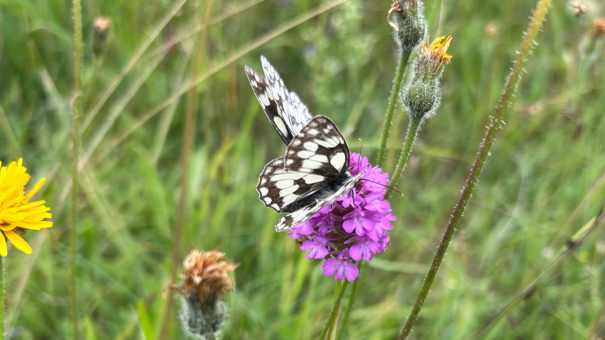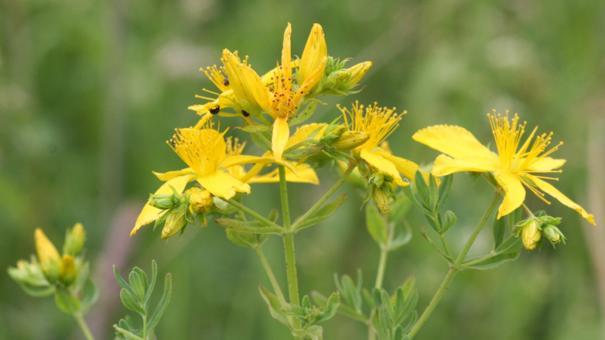We couldn’t have picked a hotter day for the visit to Coulters Dean, and the heat probably was the reason why a select band of only seven of us (less than half the expected number) were welcomed to the nature reserve by Fiona Haynes, the Hampshire and Isle of Wight Wildlife Trust (HIWWT) Reserves Officer in charge of the site.
In fact, a slight breeze picked up, bringing the sound of yellowhammers singing in the nearby hedgerows and some cloud cover, which made the heat more bearable as we walked around this beautiful 4-hectare downland site on the northern side of the South Downs, not far from Buriton and Ditcham Park. Named 'coulter'- a blade on early ploughs which cuts vertically through the soil in front of the ploughshare - and 'dean'- the Saxon word for valley, it is situated on the side of a valley and bounded by beech and whitebeam woodland to the East, and extensive cultivated fields of barley to the West. The presence of plants such as round-headed rampion, horseshoe vetch and clustered bellflower, as well as 11 species of orchid, indicate that it is ancient chalk grassland.
Fiona explained that the reserve has some interesting connections to Sir Arthur Tansley who could be regarded as the father of ecology, and who made observations at Coulters Dean in the early part of the last century, and Francis Rose, an eminent field botanist who wrote many field guides and lived in this area in his later life. She told us that the reserve had recently been extended from the original 2.2 hectares Site of Special Scientific Interest (SSSI) to 4 hectares, by the addition of a strip of the field owned by the Buriton Estates, which had been left uncultivated for several years to let nature take over, before being bought by HIWWT with the help of donations in wills and a grant from the Southern Co-op.
We started by walking through this 'newer' strip, and were delighted first by the discovery of a huge privet hawk moth, the largest of our British moths, well-hidden in the vegetation. It didn’t seem inclined to fly away and we were treated to a very close look at it when Fiona picked it up. Its caterpillars, as its name suggests, feed on privet but also on ash.

Amongst the various butterflies fluttering around the meadow were marbled whites, meadow browns, ringlets, large whites, dark green fritillaries, small skippers and gatekeepers. A pair of the rare Duke of Burgundy butterflies had been spotted earlier in the year but it was too late to see them now. There were plenty of common spotted orchids dotted throughout the grassland mostly going to seed, as well as pyramidal orchids and butterfly orchids, and we were lucky to spot one bee orchid which was still flowering.
There was a great deal of old man’s beard (Clematis vitalba) growing across the area which will need to be managed before it takes over completely, in fact the whole area will probably be lightly grazed using a small herd of sheep to get back to the chalk downland turf. However, this could have consequences for the Duke of Burgundy butterflies who like to lay their eggs on the larger leaves of cowslips. If sheep are allowed to graze for any length of time, they nibble everything to a low level and next year’s cowslips growing in the open will tend to be smaller-leaved and not so attractive to the butterflies, whose caterpillars need large juicy leaves to sustain them through the heat of summer. Of course, other species may thrive when the grassland is cropped, so the management of the reserve has to include many varied habitats if you want to allow all the species present to flourish.
Image: marbled white butterflies on pyramidal orchid

We continued back into the original fenced SSSI area and here we found a slightly different flora, with stands of nettle-leaved bellflower in the slightly more shaded areas, and in the less-shaded areas quite a few round-headed rampion and lots of greater knapweed, common valerian, St John’s Wort and hawkweeds. There was also the quaintly named Squinancywort which is in the bedstraw family and according to old herbals was used as a concoction to gargle to cure sore throats, squinancy or quinsy being the old English word for a throat infection. Young saplings of hazel, whitebeam and dogwood were thriving here and these will need to be removed to preserve the downland character.
Sharp-eyed Fiona spotted a very beautiful female wasp spider, a species which has fairly recently arrived from the European continent. How did she know it was female? The female is much larger and has vibrant black, yellow and white stripes that mimic a wasp, whereas the male is small and drab. According to the internet the male has to wait until the female moults before rushing in to mate with her whilst her jaws are still soft. Many males still get eaten, so it’s a dangerous business!
Image: perforate St John's wort
We also passed the seeding remains of many common twayblade orchids, and some narrow-leaved helleborines, (we were a bit too late to see the orchids in their full glory this year especially after such a prolonged hot dry spell) and on a slightly more open patch there was a good stand of horseshoe vetch, flourishing.
Back at the start of the reserve, the group split and a few of us continued along into the shady wooded area to see some broad-leaved helleborines coming into flower and we found an empty shell of the round-lipped snail, which more closely resembles a periwinkle than a terrestrial snail. It favours chalk or limestone areas, is becoming threatened by habitat loss in Central Europe, and is in decline in eastern England. Despite a quick search of the area, the locally-renowned 'cheese snail' remained elusive, no doubt hiding away, finding the extreme dry conditions not to its taste.
We would like to thank Fiona for giving us such an interesting tour of the reserve and perhaps a few of us will be inspired to join some of the many work parties that she has planned for the cooler months of the year. We also have to thank Di Mitchell and her band of volunteers who have looked after the reserve for many years previously. Coulters Dean may be one of HIWWT’s smallest reserves but it is certainly a very fine and important example of chalk downland.
Images below (clockwise from left): round-headed rampion; squinancywort; clustered bellflower; bee orchid; privet hawk-moth; wasp spider






